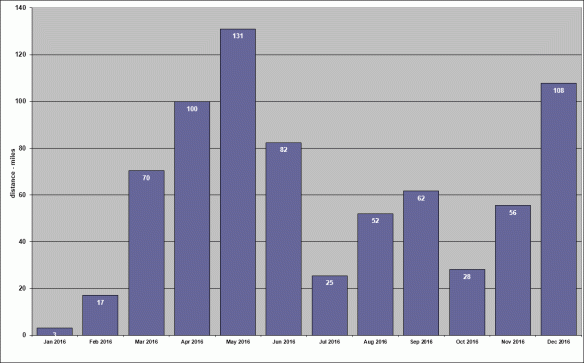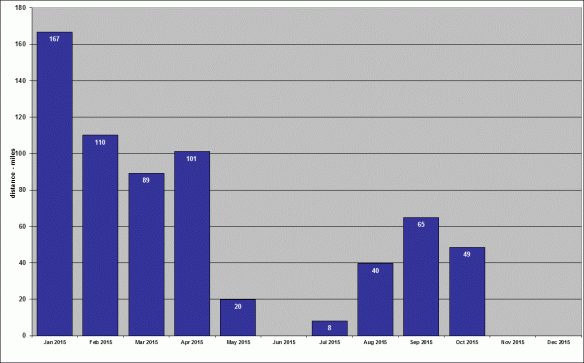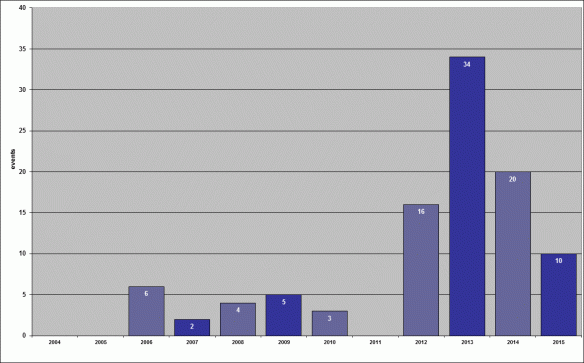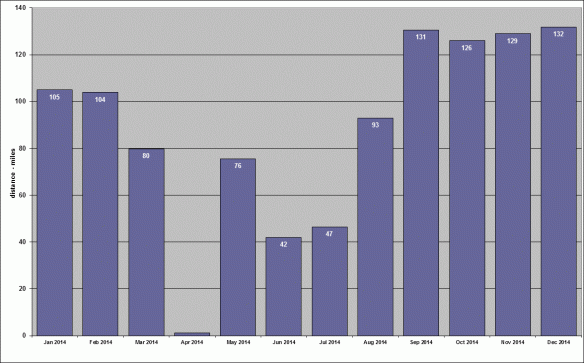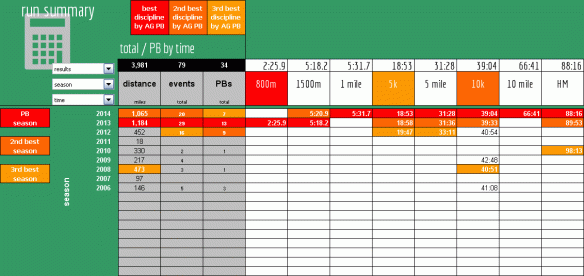Rules of thumb, I love them. A little maths, useful and concise. For example, I came across this one recently; “the perfect blog post title references an ordered list, contains six words and at least one prime number.” Very recently. Unfortunately as a rule of thumb this fails because a true rule of thumb is borne out in practice rather than made up on the spur of the blog.

There’s a reason why this definition is on a t-shirt, but I’m not quite sure now what it is.
And talking of the spur of the blog, this post is dedicated to running blogger Boy On The Run. Not that this is an obituary or anything, just that he’s a much less introspective, more disciplined and generally more reliably informative and amusing bloggist than this one. Homage, tribute, pastiche, sycophancy, plagiarism. It’s all here.
Let me see those thumbs …
| 1 |
“Calories burned equals distance in kilometres multiplied by weight in kilogrammes” |
This is pretty accurate and in fact rather usefully errs on the side of caution so you can be absolutely sure your post run treat won’t outweigh the good you just did. The Runners World calculator multiplies the rule of thumb result by 1.036, though this too is an estimate. The true factor will vary from individual to individual primarily dependent upon metabolic efficiency converting food to energy and running efficiency converting energy to forward motion.
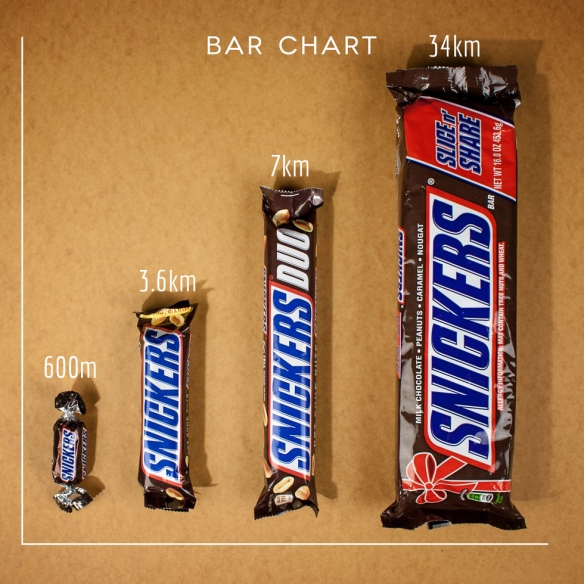
Other brands of post workout recovery nutrition are available.
| 2 |
“Every pound of excess weight lost equals a 2 seconds per mile increase in pace.” |
I’ve seen it argued that this rule is simply unsubstantiated running lore and elsewhere that whilst it is research based the paper only looked at performance over 5k. (It may even have been this piece of research, but I can’t even read all the long words let alone follow the maths.) Even so it is very appealing to extrapolate to various race distances and I have found it highly motivating when contemplating weight loss in the light of my target running weight.
| weight loss |
race time improvement |
|
5k |
10k |
half marathon |
marathon |
| 1 lb |
0:06 |
0:12 |
0:26 |
0:52 |
| 2 lbs |
0:12 |
0:24 |
0:52 |
1:44 |
| 5 lbs |
0:31 |
1:02 |
2:11 |
4:22 |
| 10 lbs |
1:02 |
2:04 |
4:22 |
8:44 |
| 1 kg |
0:13 |
0:27 |
0:57 |
1:55 |
| 2 kg |
0:27 |
0:54 |
1:55 |
3:51 |
| 5 kg |
1:08 |
2:16 |
4:49 |
9:38 |
| 10 kg |
2:16 |
4:33 |
9:38 |
19:16 |
| 3 |
“A change in pace of 10 seconds per kilometre equals 15 seconds per mile.” |
Starting from the premise that a pace of 5 minutes per kilometre is equivalent to 8 minutes per mile this rule enables fairly easy mental estimation of equivalent paces starting from either unit. Despite my age I’ve come to think primarily in pace per kilometre, probably because most of my early races were over 10k where the link between goal time and metric race pace is so straightforward. However joining my first running club, Beckenham RC in January 2013, introduced me to a culture where mile pace was the norm. I find this rule useful to convert club night run paces as they are announced; “8:30 miles … so that’s 2 fifteens over 8 minute miles, so 2 tens over 5 minute kilometres … 5:20. OK, that suits me.” It’s also helpful when chatting with other runners to be able to converse in whichever unit system they prefer.
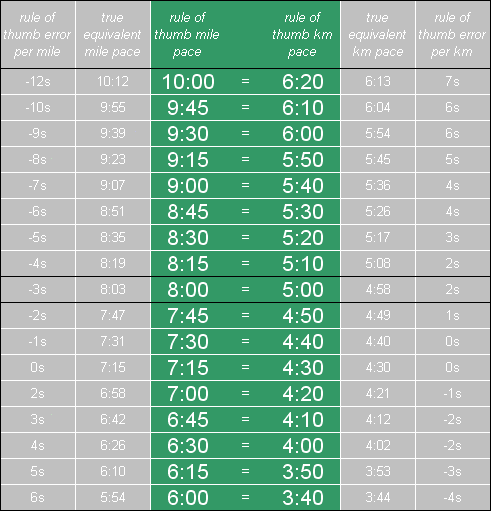
If this was a post by Boy On The Run this image would feature a donkey wearing a Spiderman costume in a Greek island idyll. But it isn’t and it doesn’t. It’s tabulated data. I can’t help myself.
It’s clear that this rule becomes less accurate the further from the original premise the desired pace lies. Fortunately for me my range of easy paces is centred exactly around the 5 minutes per km / 8 minutes per mile pair of values and so a faster or slower easy run will still lie well within the range illustrated above and hence will be accurate enough in most contexts. A simple corollary of “10 seconds per kilometre equals 15 seconds per mile” is of course “20 seconds per kilometre equals 30 seconds per mile” and using this to illustrate the results even further from the original premise does reveal the limitations.
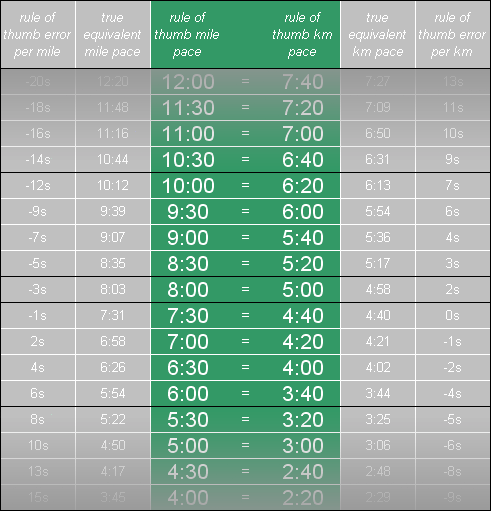
“To infinity and beyond!” OK, not Spiderman. And not desperately relevant to the image, but that doesn’t deter Boy On The Run either.
| 4 |
“Multiply race time by 2.1 to predict race time over twice the original distance.” |
This can be used to predict, or at least set realistic goals for, different race distances based on existing race times. It’s usefulness is slightly limited by the fact that race distances are not all inter-related in terms of being double, or half, of another; the mix of metric and imperial race distances doesn’t help. Nonetheless 1500m/3000m, 5k/10k, 5 mile/10 mile and half marathon/marathon are all such pairs. Trying to apply the rule to shorter distances doesn’t work so well which is a shame since 100m/200m/400m/800m/mile (1609m) makes a great related set. My intuition is that this is because the transition from entirely anaerobic to predominantly aerobic events occurs over this range of distances.
Certainly over the distances for which I have PB pairs the relationship is very close to this rule; 5k/10k 18:55 PB/predicts 39:44 (39:33 actual), 5 mile/10 mile 31:36 PB/predicts 66:22 (66:41 actual).The corollary of the rule, used to work from a longer race distance to a shorter one, is of course to “divide race time by 2.1 to predict race time over half the original distance.” This is the hardest do mentally, but it is worth digging out a calculator for if necessary. Personally I’ve whiled away many minutes during longer runs calculating and recalculating my predicted marathon time from my current half marathon PB. Calculating the km pace required to achieve this can easily keep me occupied for the rest of the run.
As with all calculations of this type the rule takes no account of natural ability favouring longer or shorter race distances, rather it assumes absolutely equal ability and quality of preparation over all distances.
| 5 |
“Racing over middle and long distance hurts in inverse proportion to the distance.” |
This is probably as good a time as any to note that this rule is casually plagiarised and paraphrased from Boy On The Run’s original in his post “the different types of runner – part 5” where it appears as “Running hurts. If you are a marathon runner it hurts a fair amount for a long time. If you are a mile runner it hurts A LOT for a short while.” You may be pleased to read that it involves no maths whatsoever and so probably doesn’t qualify as a true rule of thumb. I’m not even sure what my personal relationship is to this rule just yet.
As mentioned previously I started out racing predominantly over 10k; my first event was in 2006. Since my 2012 return to running I have raced predominantly over 5k, thanks to parkrun, and have only very recently run my first handful of races of less than 5k and hence “middle distance”. Reviewing my performances in those I think I subconsciously adopted my long standing, long distance habits; starting out carefully, settling in to goal pace after a few hundred metres and then containing effort to ensure I was able to maintain my goal pace to the end.
On reflection I realise that optimal middle distance performance requires a sharp start, adopting goal pace with a few tens of metres and then pushing the limit hard throughout. I think that racing in that way is much more likely to bring me into contact with the intensity of lactic acid pain that middle distance racing is famous for. To date I think I’ve experienced greater mental and emotional discomfort in races, typically in longer races like half marathons, than I have lactate running pain. And certainly nothing approaching the levels described by true middle distance runners.
I am perversely looking forward to pushing myself further towards it.


